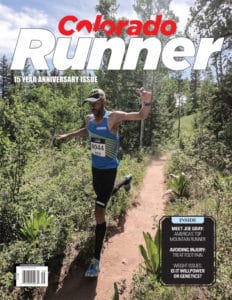 Trail Running 101
Trail Running 101
Ready to run on Colorado’s Trails? Here’s a few tips to keep in mind before you head out the door
If you’re ready to head off the beaten path, it can seem intimidating at first to some runners. It’s easy to keep running your same concrete loop around your house day in and day out. There’s peacefulness in the sameness. When you’re feeling up for adventure, heading out onto Colorado’s trails can be rewarding and fun.
Trails can be quite different, depending on what you’re ready to tackle. There are the wide, smooth, crushed gravel paths around Denver that are similar to running on the roads. Then, on the opposite extreme, there are the rocky, hilly, single track trails with exposed tree roots in the high country that may leave you breathless and walking slowly. No two trails are identical and you need to plan accordingly, depending on the extremeness of what you’re planning to run.
Here are a few tips to keep in mind.
1. Slow down. Trail running can be a hit to the ego. Find a new pace that feels comfortable. It can be more challenging than running on roads and sidewalks, so don’t be stressed out if it takes you twice as long to cover the same mileage. Run based on effort or heart rate or perceived exertion, rather than your miles per hour pace. If you need to change gears and walk that uphill, don’t sweat it. Enjoy the journey.
2. Follow the rules. Don’t litter. Stay on marked trails only. Don’t run on trails when they are muddy. Don’t make the trails wider by running around the edges. Yield to other trails users, such as horses. Uphill runners yield to downhill runners. Leave no trace.
3. Be Safe. Take a cell phone and an I.D. with you. Take water and a snack if you’ll be out for awhile. Leave a note at home, so someone can figure out where you went. Don’t wear headphones so that you can be aware of your surroundings and stay alert. Review the trail map and have a route planned before you begin.
4. Buy trail gear. The first time you hit the dirt in your shiny white running shoes and socks will be your last because they will come home caked in dirt. It’s a good idea to invest in trail running shoes, not just because the darker color will hold up better in the dirt, but because the rugged tread will give you a better grip on the trail and the profile should help reduce the chance of ankle rolls. Gaiters can keep rocks from entering your shoes. Wear sunscreen, sunglasses, a hat, and bug spray, in needed. You may need to buy a hydration pack or waist belt for fluids.
5. Balance is key. Moderation is key when you are starting something new. Trail running can use different muscles than road running, so you may want to ease into it gradually. You may find that your knees, or shins, or hips are sore if you overdo it. It’s all about balance. Build up your trail mileage over time to stay injury free. You may find that you need to use your arms a bit more than you’re used to. You may need to hop over obstacles like tree roots, which is something your body isn’t used to doing on the roads. Try using short, quick strides when climbing. Have fun!
Happy Trails,
Derek Griffiths
